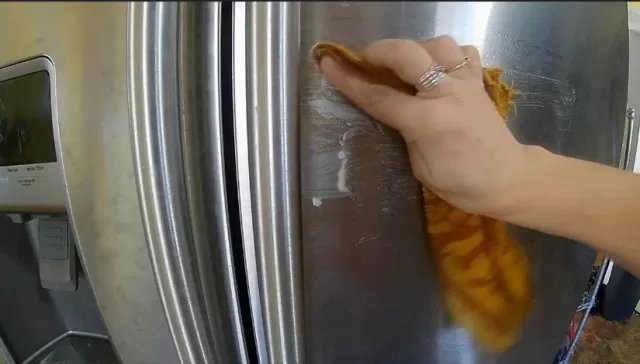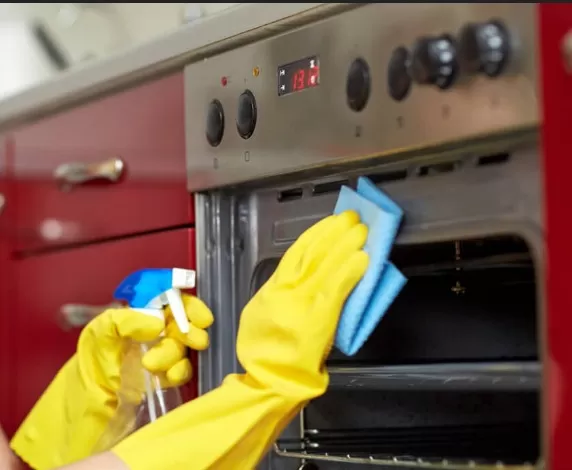Stainless Steel Appliance Mistakes to Avoid. To keep your stainless steel appliances and items looking sleek and shiny, it’s crucial to avoid some common cleaning mistakes. Stainless steel is a popular choice for its durability and modern appeal, but improper cleaning can lead to unsightly streaks, scratches, and damage. Let’s explore the essential tips to protect your stainless steel and maintain its luster for years to come.
Firstly, never use abrasive scrubbers or harsh chemicals when cleaning stainless steel. Steel wool, rough brushes, or abrasive pads can leave scratches and permanent marks on the surface, ruining its smooth finish. Instead, opt for soft cloths, microfiber towels, or gentle sponges to wipe away dirt and grime.
Secondly, be cautious about using bleach or ammonia-based cleaners on stainless steel. These harsh chemicals can cause discoloration and pitting, affecting the stainless steel’s appearance and Durability. Instead, opt for mild, non-abrasive cleaners specifically designed for stainless steel surfaces.
Furthermore, avoid leaving water spots or detergent residues on the stainless steel. After cleaning, always rinse the surface thoroughly with Clean Water and dry it immediately with a soft cloth. This prevents mineral deposits and soap scum from accumulating, which can mar the shine of the stainless steel.
Preserving the Brilliance of Stainless Steel: Essential Tips for Long-lasting Luster

Stainless steel, known for its sleek and modern appearance, has become a popular choice for kitchen appliances due to its dazzling finish and minimal upkeep.
With its inherent protective film, stainless steel retains its stunning look for years. To ensure that your stainless steel appliances maintain their pristine condition, it is vital to prioritize their maintenance through regular cleaning.
However, it is equally important to be aware of the potential pitfalls that can lead to scratches, loss of shine, and the erosion of the protective layer. Expand your knowledge by exploring the following guidelines, which outline common mistakes to avoid when cleaning stainless steel.
By implementing these tips, you can extend the longevity of your stainless steel appliances and keep them looking radiant for many years to come.
The Hazards of Using Abrasive Cleaners on Stainless Steel
The composition of stainless steel comprises various elements such as iron, chromium, manganese, silicon, and carbon.
When exposed to oxygen in the air, these elements combine to create a delicate protective film that shields the steel from rust and corrosion. Unfortunately, the use of abrasive cleaners can undermine this protective layer, leading to scratches and harm to the steel’s natural grain. Over time, this damage can pave the way for rust formation and compromise the integrity of the stainless steel surface. To prevent such detrimental effects, it is crucial to steer clear of cleaning powders and liquids that contain abrasive ingredients like calcite, feldspar, quartz, and silica. By avoiding these abrasive cleaners, you can safeguard the longevity and pristine appearance of your stainless steel appliances.
Protecting the Surface: Cleaning Stainless Steel with the Grain

If you observe stainless steel closely, you’ll notice subtle lines or patterns known as the grain.
These grain lines are inherent to the material and contribute to its unique appearance. When it comes to cleaning stainless steel, it’s important to remember to scrub, wipe, or polish the surface in alignment with the grain, rather than against it.
This mindful cleaning technique serves multiple purposes.
Firstly, cleaning in the same direction as the grain helps to reach into the tiny crevices and cracks that may be present on the surface, effectively removing any trapped dirt, dust, or grime.
By following the grain, you ensure a more thorough cleaning process.
Secondly, avoiding scrubbing against the grain is crucial to prevent scratching the stainless steel surface.
The grain acts as a natural guide, and scrubbing in the opposite direction can create friction that may lead to unsightly scratches or abrasions. By maintaining a consistent cleaning motion along the grain, you minimize the risk of damaging the stainless steel.
So, whenever you embark on a cleaning session for your stainless steel appliances or surfaces, remember to work in harmony with the grain.
This approach will not only help maintain the visual appeal of your stainless steel but also ensure a safer and more effective cleaning experience overall.
Dealing with the Effects of Hard Water on Stainless Steel
Despite diligently adhering to proper cleaning practices, you may occasionally encounter frustrating spotting and staining on your stainless steel appliances.
When faced with this issue, the culprit behind these imperfections may very well be your tap water. Hard water, characterized by its high mineral content, has the potential to leave unsightly streaks and stains on stainless steel surfaces. However, with a few additional measures, you can effectively combat this problem and maintain the pristine appearance of your appliances.
One essential step in preventing hard water-related issues is to ensure thorough drying of the stainless steel surfaces after cleaning.
By employing a soft towel, carefully dry the appliances to remove any lingering moisture. This approach significantly reduces the chances of mineral deposits settling on the stainless steel and causing stubborn stains.
If you do encounter hard water stains, worry not.
A simple yet effective solution involves using a damp cloth and a small amount of white vinegar. Gently wipe the affected areas with the damp cloth dipped in vinegar.
The acidic properties of vinegar work effectively to dissolve and remove mineral deposits, restoring the stainless steel’s gleaming surface. Afterward, rinse the surface with clean water and dry it thoroughly as previously mentioned.
By being mindful of the potential impact of hard water, and implementing these additional steps, you can successfully combat spotting and staining on your stainless steel appliances.
With consistent care, your stainless steel surfaces will continue to exude their brilliance, enhancing the overall aesthetic of your kitchen or living space.
Choosing the Right Tools: Gentle Cleaning for Stainless Steel

Although stainless steel is renowned for its durability, it is not impervious to scratches.
When it comes to cleaning stainless steel, it’s crucial to be mindful of the tools you use. Abrasive Cleaning Tools like steel wool and harsh scrub brushes can pose a risk to the surface, resulting in unsightly scratches and a loss of its lustrous shine.
Moreover, these abrasive tools can compromise the protective film that safeguards the steel from rust and corrosion.
To ensure the longevity and aesthetic appeal of your stainless steel appliances, it is highly recommended to opt for a gentler approach.
The best tool for cleaning stainless steel surfaces is a soft microfiber cleaning cloth. Microfiber cloths are designed to be non-abrasive, making them ideal for safely wiping away dirt, fingerprints, and smudges without causing damage.
They effectively remove grime and maintain the integrity of the protective film, helping to preserve the steel’s natural beauty.
When cleaning, simply dampen the microfiber cloth with water or a mild stainless steel cleaner, and gently wipe the surface, following the grain of the steel.
This gentle cleaning method ensures that your stainless steel remains scratch-free and retains its high-shine finish.
By opting for a soft microfiber cleaning cloth and avoiding abrasive tools, you can effectively clean and maintain your stainless steel appliances, keeping them looking their best for years to come.
*The information is for reference only.